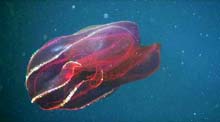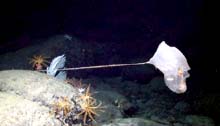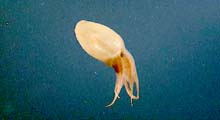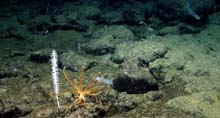Davidson Farewell
February 4, 2006
We are conducting the final dives of our Davidson Seamount: Exploring Ancient Coral Gardens cruise; and we are readying for our return to port. This has been a productive and successful expedition, and we hope you've enjoyed following along with us. Thank you for your questions!
One group you haven't heard much about in these logs is the crew of the research vessel Western Flyer. It's amazing how so few of them — 10 ship's crew and 5 remotely operated vehicle (ROV) pilots — keep everything running so smoothly. They have moved the ship everywhere we needed to go, made sure our emails went out, deployed and retrieved current meters, fed us like royalty, and kept everything in proverbial ship-shape. The crew also took an active interest in our research and proved to be excellent company. Thank you to relief-Captain Darrell Palmer and crew!
To wrap up our journey to Davidson Seamount, we asked all of the explorers the following question: "What has been your most memorable event or discovery during the cruise?" Here are the replies.
"I have two most memorable moments. The first was being escorted out to the Davidson Seamount on Day 1 by Pacific white-sided dolphins, Dall's porpoises, and Northern right whale dolphins. The second was seeing the red lobate comb jelly, Lampocteis, on Day 4. It was one of the most beautiful organisms I have ever seen. Its bizarre form, and remarkable color and motion proved that truth is stranger than fiction." — Huff McGonigal, Monterey Bay National Marine Sanctuary (MBNMS)
"My most memorable observation, was the small field [about 20] of the stalked tunicate, Culeolus sp. I had never seen these before, and they were amazingly large [about the size of a large orange]. The profile looked like a small dog's head." — Erica Burton, MBNMS
"There have been so many great discoveries on this cruise, it's really hard to pinpoint any one. I'm fascinated by how different each dive is. We start thinking that we can predict what we'll see on any given dive and are completely surprised when we find a totally different group of organisms than we had expected to find. I'm also thrilled by the unique biology that we collected. Today's unusual coral was a great find. In the several hundred hours worth of time spent looking at seamounts I have never seen the coral that we collected today. It was also exciting to see the Culeolus tunicates and the rest of the diversity that we saw on "Big Easy." And how about that mid-water octopus? This cruise has been one of my favorites. Davidson Seamount is such an amazing place! It's also been great to work with everyone so closely. Cruises like this allow us to get to know each other just a bit better than during the usual 9-to-5 day." — Lonny Lundsten, Monterey Bay Aquarium Research Institute (MBARI)
"Exploring Davidson Seamount from the deepest valleys to the very tip of mountain peaks was incredible. All places were filled with strange forms of life that ranged from smaller-than-you-can-see-with-the-naked-eye to the grandeurs of coral and sponge gardens. I am excited about collecting and photographing corals and the opportunity to provide answers to questions about age and growth." — Allen Andrews, Moss Landing Marine Laboratories
"The first images of large stands of bubblegum coral forests emerging from the black ink of the depths, in lifelike high definition, will stand as my fondest memory of this cruise. It is hard to imagine such complex and visually stunning biological communities living in the harsh conditions of this sunless world." — Chad King, MBNMS
"Just being a part of this cruise, after so much planning, has been a highlight. I enjoyed seeing how the work all comes together in the labs, in the moonpool, in the control room, on the bridge, in the galley. The swimming crinoids, stalked tunicates, brooding octopus, Picasso sponges, and, of course, the huge bubblegum corals, were the visual high points." — Lisa Borok, MBARI
"The best moment for me was my first sighting of the Davidson Seamount summit, covered in huge and colorful corals and sponges. We'd heard such great things about this location, but sometimes the reality doesn't quite live up to expectations. It was a great excitement (and relief) to see that this was going to be a visual feast for the camera!" — Penny Allen, British Broadcasting Corporation (BBC)
A swimming crinoid, also called a feather star (Florometra sp.). Click image for larger view and image credit.
"I find the very distinct distribution patterns of some of the corals on Davidson Seamount to be amazing. Paragorgia, in particular, tends to inhabit only the steepest slopes and shallowest peaks of the seamount. I am intrigued by the possible factors that might limit its success to these microenvironments. Several factors, from the ability of larvae to settle and grow to stages invulnerable to common predators, to the effects of current patterns on feeding success, survival, and reproduction by adults, may each play a role. It is a thrill to view these animals over the dramatic sub-sea landscape of the seamount and ponder the dynamic processes that shape these coral gardens." — Jim Barry, MBARI
"Especially memorable to me are large sponges and tunicates with most of their bodies on the tip of long, thin stalks. The shapes look almost ridiculous yet beautiful, and are perfectly arranged to reach higher in the water column for the relatively scarce bits of food. I doubt anyone would even think of these shapes if they were presented with an opportunity to design an animal." — Andrew DeVogelaere, MBNMS
"My most memorable event was seeing a ctenophore at 500 meters depth lit up on a high definition [HD] screen in the remotely operated vehicle Tiburon's control room. The colorful, pulsing iridescence of the ctene rows on this beautiful creature is nothing less than stunning. For me, this is what HD is all about. To borrow a quote from our illustrious series producer, this is 'quite literally the first time this remarkable behavior has ever been filmed' (by me, anyway). My best discovery of the cruise was without doubt the stash of Wonka bars in the cupboard under the microwave." — Warwick Sloss, BBC
Sign up for the Ocean Explorer E-mail Update List.

























